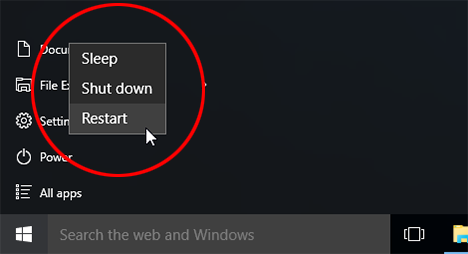The Reboot Ritual: A Comprehensive Guide on How to Restart Windows 10

Introduction:
Restarting your Windows 10 system is a fundamental practice that can resolve various issues, refresh system resources, and ensure optimal performance. While restarting may seem like a straightforward task, there are multiple methods and considerations to explore. In this comprehensive guide, we will delve into the intricacies of restarting Windows 10, covering the standard procedures, advanced options, and troubleshooting techniques. Whether you’re a seasoned user or a newcomer to the Windows environment, understanding the nuances of restarting is crucial for maintaining a healthy and responsive system.
Basic Methods to Restart Windows 10:
Method 1: Using the Start Menu
- Open the Start Menu:
- Click on the “Start” button in the bottom-left corner of the screen.
- Click on Power:
- Click on the “Power” icon, represented by a circle with a vertical line inside.
- Select Restart:
- From the power options menu, select “Restart.” Windows 10 will initiate the restart process.
Method 2: Using the Ctrl + Alt + Del Menu
- Press Ctrl + Alt + Del:
- Simultaneously press the
Ctrl + Alt + Delkeys on your keyboard.
- Simultaneously press the
- Access Power Options:
- Click on the “Power” icon in the bottom-right corner.
- Choose Restart:
- Select “Restart” from the power options menu to commence the restart.
Method 3: Using the Command Prompt or PowerShell
- Open Command Prompt or PowerShell:
- Press
Win + Xand choose “Command Prompt” or “Windows PowerShell” with administrative privileges.
- Press
- Run Restart Command:
- Type the following command and press Enter to restart your computer.
shutdown /r /t 0The/rswitch indicates a restart, and/t 0specifies that the restart should occur after a delay of 0 seconds.
Method 4: Using the Run Dialog
- Open the Run Dialog:
- Press
Win + Rto open the Run dialog.
- Press
- Run Shutdown Command:
- Type the following command and press Enter.
shutdown /r /t 0This command initiates a restart with no delay.
Advanced Restart Options:
Method 5: Using the Settings App
- Access the Settings App:
- Open the “Start” menu and click on the “Settings” gear icon (alternatively, press
Win + I).
- Open the “Start” menu and click on the “Settings” gear icon (alternatively, press
- Navigate to Update & Security:
- In the Settings window, select “Update & Security.”
- Choose Recovery:
- Click on “Recovery” in the left-hand menu.
- Advanced Startup:
- Under the “Advanced startup” section, click on “Restart now.”
- Select Restart Option:
- Once the system restarts, you’ll be presented with advanced startup options. Choose “Restart now” under “Choose an option” to restart your computer.
Method 6: Using System Configuration (msconfig)
- Open Run Dialog:
- Press
Win + Rto open the Run dialog.
- Press
- Access System Configuration:
- Type “msconfig” and press Enter to open the System Configuration utility.
- Navigate to Boot Tab:
- In the System Configuration window, go to the “Boot” tab.
- Check Safe Boot Option:
- Check the “Safe boot” option if you want to restart your computer in Safe Mode.
- Apply Changes and Restart:
- Click “Apply” and then “OK.” When prompted to restart, select “Restart.”
Troubleshooting Restart Issues:
- Check for Pending Updates:
- Ensure that your system doesn’t have pending updates, as some updates may require a restart to take effect.
- Review Running Applications:
- Close any open applications before restarting to prevent data loss or conflicts.
- Verify Hardware Connections:
- Check that all external devices are properly connected, as faulty connections can lead to restart issues.
- Examine System Logs:
- Review the Event Viewer or Reliability Monitor for any error messages or warnings related to system restarts.
- Perform a System File Check (SFC):
- Open Command Prompt with administrative privileges and run the following command to check for and repair corrupted system files.
sfc /scannow - Check for Driver Updates:
- Ensure that your device drivers are up-to-date, as outdated drivers can cause stability issues.
Conclusion:
Restarting Windows 10 is a routine but crucial task for maintaining the health and performance of your system. Whether you opt for the simplicity of the Start menu, the versatility of the Command Prompt, or the advanced options available in the Settings app or System Configuration utility, this guide has equipped you with a comprehensive understanding of the various methods and considerations involved in restarting Windows 10. By incorporating these techniques into your computing routine and addressing potential issues proactively, you can ensure a seamless and efficient Windows experience.







